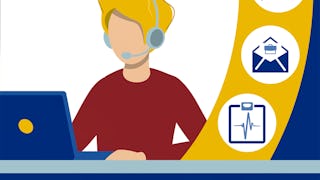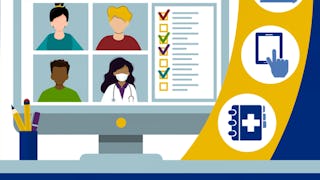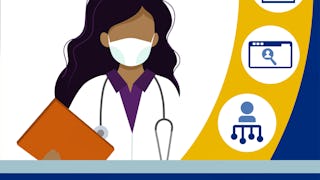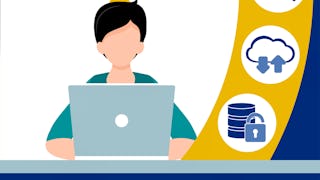Now that you've been introduced to the world of Health IT and the important role played by electronic health records (EHRs), we'll focus on other technologies that play a role in maintaining ongoing operations in healthcare. Telemedicine, patient portals, barcode scanners, printers, and medical devices are just some of the technologies that impact providers and patients. As an IT support specialist, you’ll be asked to troubleshoot issues with a wide variety of tools. You'll see a scenario with a medical device installation where issues related to IP addresses, networking, and MAC addresses come up.

Enjoy unlimited growth with a year of Coursera Plus for $199 (regularly $399). Save now.

Operations and Patient Safety for Healthcare IT Staff
This course is part of Healthcare IT Support Specialization


Instructors: Ashwini S. Davison, M.D.
11,306 already enrolled
Included with
(203 reviews)
Skills you'll gain
- Issue Tracking
- Practice Management Software
- Disaster Recovery
- Telehealth
- Medical Equipment
- Medical Devices
- Change Requests
- Software Installation
- Help Desk Support
- Health Technology
- Technical Communication
- Desktop Support
- Technical Documentation
- Patient Safety
- Network Support
- General Networking
- Health Care
- System Support
- Technical Support
- Change Control
Details to know

Add to your LinkedIn profile
5 assignments
See how employees at top companies are mastering in-demand skills

Build your subject-matter expertise
- Learn new concepts from industry experts
- Gain a foundational understanding of a subject or tool
- Develop job-relevant skills with hands-on projects
- Earn a shareable career certificate

There are 4 modules in this course
In this module you will learn about telemedicine and patient portals. These are 2 important technologies in healthcare that are playing a bigger role in the patient and provider experience. You’ll learn about different types of telemedicine delivery such as asynchronous, synchronous, and remote patient monitoring. You’ll hear from the Director of Telemedicine about what it was like introducing virtual visits in a rapid fashion during the early days of the COVID-19 pandemic. As an IT support staff member, you’re not just tasked with providing support to physicians, nurses and other allied health professionals. You’ll also be called on to support patients or their caregivers when they run into challenges with telemedicine visits or patient portals. During this module, you’ll watch a scenario where an IT Help desk agent helps a concerned parent who is trying to access some billing information regarding his son. Pay attention to the calm way in which the agent helps him complete the proxy and guarantor information that is needed in order to gain the proper access. We’ll also take you behind-the-scenes during a medical device installation. Watch as a system field engineer installs a new piece of radiology equipment. Through this real- world scenario, you’ll be introduced to concepts of IP addresses, MAC addresses, and networking issues (LAN, WLAN).
What's included
6 videos5 readings1 assignment
There are many different operational needs in Health IT. In your future job, you may be helping to troubleshoot a network outage that takes place during implementation of an Electronic Health Record (EHR) at a hospital. Perhaps there’s a dashboard in the command center that is not working. There could be patient safety issues arising from a recent flood in the basement of an ambulatory surgical center. Regardless of where you work in Health IT support, concepts like self-service tickets, priority levels, tiered support and various help desk resources will play a role. In this module, you’ll watch a demo of the steps taken by the provider when initially submitting a self-service ticket. We’ll also cover situations where a self-service ticket shouldn’t be submitted because of the criticality or severity of the issue. Be rest assured that in addition to relying on your training and strong problem-solving skills, there will be other resources at your disposal when you begin working in Health IT Support. Examples include a standard list of questions to ask when on a help desk call, troubleshooting documents, tip sheets and knowledge base articles. Help desks can’t script every single scenario that’s encountered. But especially when you first start in a new role, having a list of standard questions that might be appropriate regardless of the call type is useful. It won’t take you long to remember that at the start of each interaction you need to confirm the caller’s full name, their user ID, and a reliable call back number. You’ll also become savvy in eliciting information about when the problem started and whether it can be reproduced. Over time, you'll get better at distinguishing between software versus hardware issues and having a clear escalation path if It’sit’s not something you can resolve. It will take time however to gain comfort in knowing when an issue is more of an enterprise-wide problem with other sites being involved rather than just something impacting a single user. There will also be times when all your resources don’t help you with the right answer. This is where teamwork, communication, and documentation are key in helping to get a Health IT issue resolved. At the end of this module, you’ll learn about the role patient wristbands and barcode scanning in healthcare. We’ll cover some of the ways in which issues can arise that may lead to an employee contacting the help desk. We’ll wrap up with a lesson on the many uses of printers in healthcare, such as printing of specimen labels before a lab draw, medical records for a nursing home, prescriptions for a patient, disability forms for a physical therapist, or discharge instructions before a patient leaves the hospital. When you receive a call from a clinician or healthcare staff member regarding a problem with printing it can be tough to pinpoint what the exact issue is. We’ll go through a systematic approach that can you help you in isolating whether it’s an issue with the printer itself, the computer, network, or the application.
What's included
6 videos1 assignment
In this module you’ll be introduced to the JIRA process that can be used for tracking and managing changes in Health IT. We’ll share with you what the different parts that make up a JiraJIRA ticket are and some of examples of how a ticket can move towards being resolved. You’ll gain appreciation for why clear documentation is essential when working to resolve issues. Despite the best laid plans, there are of course times when health information systems are not up and running. That’s why you need to be aware of scheduled and unscheduled downtimes as well as the downtime procedures that need to be implemented when these situations occur. You’ll also get to hear about one of the toughest tickets Liz has dealt with during an unscheduled downtime.
What's included
5 videos1 reading1 assignment
In the final module of this course, we focus on patient safety. We’ll go into detail about what it means to be part of a high reliability organization in healthcare. You’ll hear about the role of Health IT in promoting patient safety. We’ll cover the importance of checklists and define concepts like medication errors, near misses, and sentinel events.
What's included
5 videos4 readings2 assignments
Earn a career certificate
Add this credential to your LinkedIn profile, resume, or CV. Share it on social media and in your performance review.
Instructors

Offered by
Explore more from Patient Care
 Status: Free Trial
Status: Free TrialJohns Hopkins University
 Status: Free Trial
Status: Free TrialJohns Hopkins University
 Status: Free Trial
Status: Free TrialJohns Hopkins University
 Status: Free Trial
Status: Free TrialJohns Hopkins University
Why people choose Coursera for their career




Learner reviews
203 reviews
- 5 stars
87.68%
- 4 stars
9.85%
- 3 stars
1.97%
- 2 stars
0%
- 1 star
0.49%
Showing 3 of 203
Reviewed on Jun 1, 2024
This course gave me a little understanding of what going on in health IT to make sure patient and save, I will definitely apply what I have learned to my job. Thanks
Reviewed on Mar 7, 2021
I found the fourth section the most interesting and enjoyable, however, all sections had new information. Thank you!
Reviewed on Aug 17, 2023
This module was the best of the 3 so far. Patient Safety is priority number 1.
Frequently asked questions
To access the course materials, assignments and to earn a Certificate, you will need to purchase the Certificate experience when you enroll in a course. You can try a Free Trial instead, or apply for Financial Aid. The course may offer 'Full Course, No Certificate' instead. This option lets you see all course materials, submit required assessments, and get a final grade. This also means that you will not be able to purchase a Certificate experience.
When you enroll in the course, you get access to all of the courses in the Specialization, and you earn a certificate when you complete the work. Your electronic Certificate will be added to your Accomplishments page - from there, you can print your Certificate or add it to your LinkedIn profile.
Yes. In select learning programs, you can apply for financial aid or a scholarship if you can’t afford the enrollment fee. If fin aid or scholarship is available for your learning program selection, you’ll find a link to apply on the description page.
More questions
Financial aid available,





